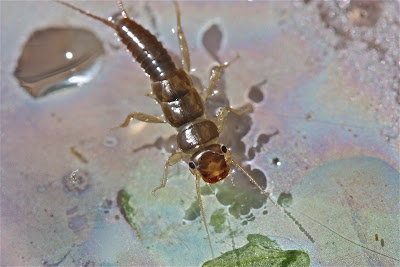Monday, April 11, 2011
The Doyles River in Spring and the Question of "Protocol"
(Perlodid stonefly: genus Helopicus)
When I first found this genus of Perlodid stonefly two weeks ago in Buck Mt. Creek (post, 4/2/11), I wondered if I'd see it again anywhere else. Sure enough, I found two more in the Doyles River today. Actually, the pair cozied up for me so I could get a group portrait. Two different sizes: two different colors -- which I think is a matter of age (the older they get the darker they get?).
I also found a lot of Diploperla Perlodids -- the most I've ever seen at one time -- and I'd have to call these "mature".
To finish up on the stoneflies -- I found one, and only one, very small Nemourid stonefly, genus Amphinemura, the genus with the "cervical" gills sticking out on both sides of the neck. This nymph was so small that I could not see the gills when I took this shot at the stream. When I cropped the photo at home, there they were. (Please click on the photo to enlarge, and please forgive me for not making this sharper -- it was a "very" small nymph.)
The actual size of this nymph was probably less than 1/4". But they will get bigger -- and darker -- through April and May, and by May, I expect to see a lot of them in our streams.
Mayflies? There were still of number of Epeorus flatheaded mayflies, and lots and lots of "spiny crawlers" (family: Ephemerellidae; genus Ephemerella). The small minnow mayflies I saw here in February in March seem to be gone -- the "Blue-winged Olives" have hatched! Rocks often had 4-6 spiny nymphs crawling around, and I had no problem getting some pictures of nymphs of various sizes.
That the gills on spinys are "on top" of the abdominal segments and do not stick out to the sides of the abdominal segments is very clear from this picture (the gills are "tan").
The mayflies today were almost all on the bottoms of rocks; the stoneflies were all, without exception, crawling around in densely packed leaves in the stream. This is pretty much what I've found to be true since I started this project. This made me wonder today about the protocol used when we sample our streams. In getting its samples, StreamWatch -- and I suspect this is true for Save Our Streams teams as well -- looks in the riffles. But I think that's a problem in terms of getting a good sense of a stream's populations. Stoneflies like leaf packs: it's where I've found them all year. And leaf packs are hardly ever in riffles -- big leaf packs at least. They're often wrapped up on limbs in the stream, or packed in behind boulders out in the current. So are we seeing as many stoneflies as we might, if we only sample the riffles?
I don't bring this up to be critical of the StreamWatch approach: their methods are top of the line, and I know that a lot of time and thought went into the development of that protocol -- the same for VA SOS. And, were there a "perfect" way to go about sampling, the "pros" would have found it by now. But when I find a lot of insects -- and a lot of good insects -- in places that I know sampling teams tend to avoid, I wonder if there isn't something we're missing.
Subscribe to:
Post Comments (Atom)






No comments:
Post a Comment